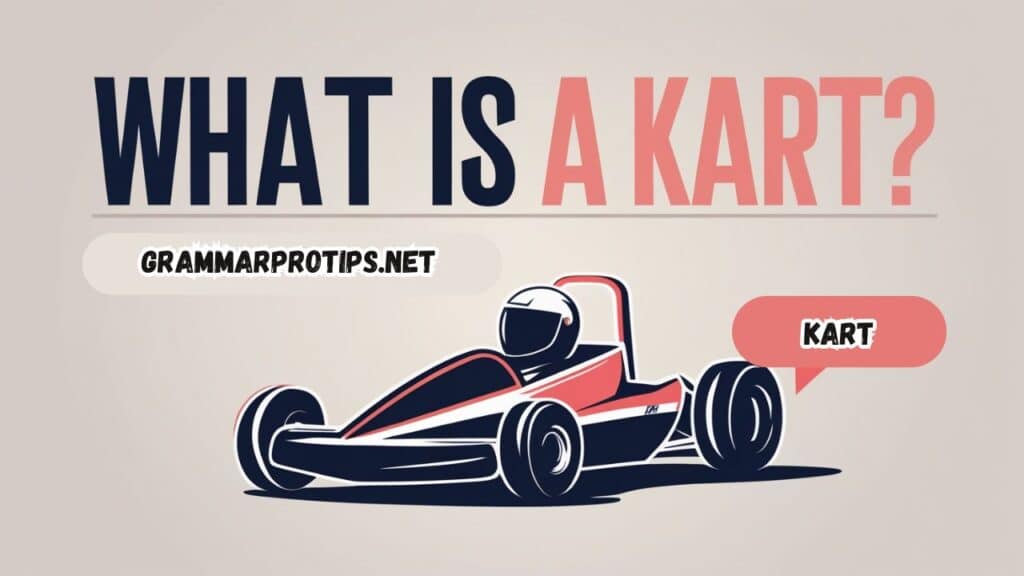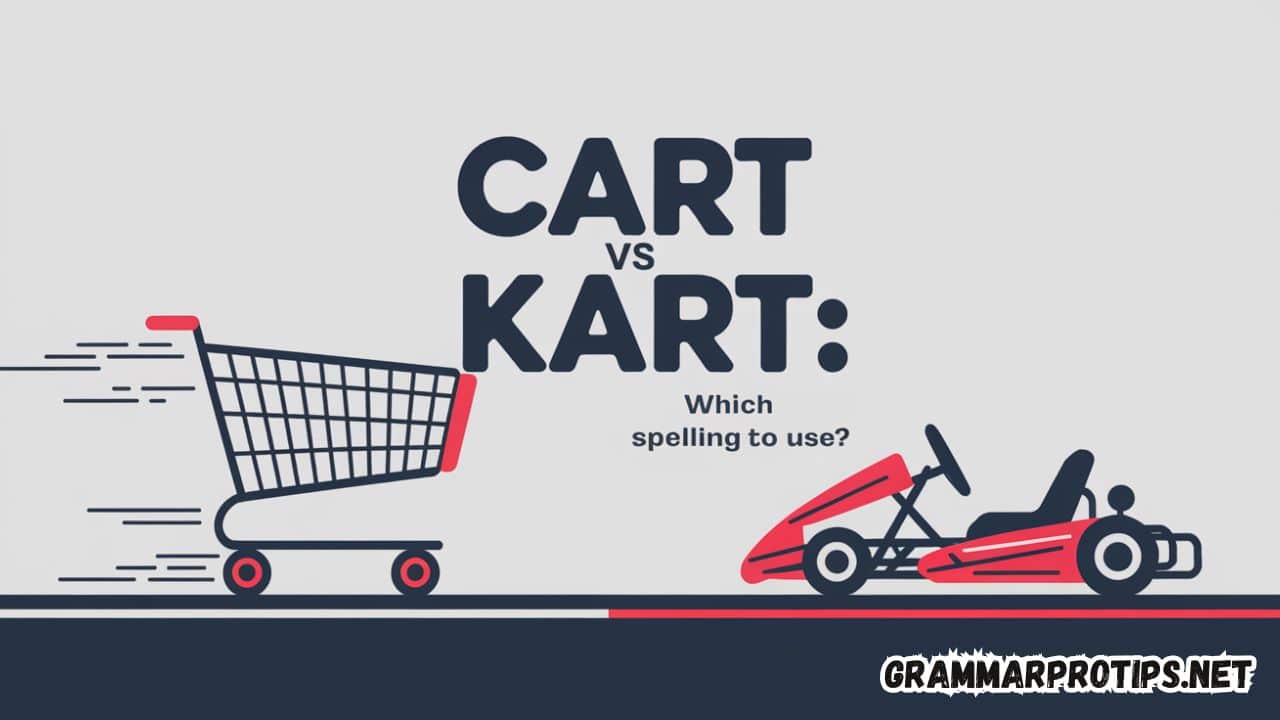Cart vs Kart: Which Spelling to Use? When it comes to the English language, some words sound incredibly similar, yet their meanings and uses can vary widely.
Two such words cart and kart are prime examples of this phenomenon.
While the words may seem interchangeable at first glance, understanding their correct usage can make a huge difference in communication, especially in contexts involving transportation, shopping, recreation, and video games.
In this comprehensive guide, we will explore the distinct meanings and uses of cart and kart, provide practical examples, and explain how each term fits into different scenarios.
Whether you’re shopping online, racing at an amusement park, or discussing historical transport vehicles, you’ll know exactly when to use cart and when to use kart.
What is a Cart?
The word cart refers to a wheeled vehicle used for carrying goods, people, or materials from one place to another.
Carts come in many forms, from those pulled by animals to modern versions used for e-commerce or grocery shopping.
The general purpose of a cart is to provide convenience when transporting items over short distances.
Common Types of Carts
- Shopping Cart: This is perhaps the most common and widely known form of cart in modern society. When you go to a grocery store, you use a shopping cart to carry your items while you shop. The design of a shopping cart has evolved over time, but it remains essential in any store that wants to make the shopping process easier.
- Hand Cart: Hand carts are smaller, manually pushed or pulled vehicles, often seen in warehouses, delivery services, or even flea markets. Delivery workers use hand carts to transport goods from one location to another, providing a quick solution for moving packages over short distances.
- Horse-Drawn Cart: In older times, horse-drawn carts were used for transporting heavy goods, typically pulled by horses. These carts were common in agricultural and trade settings, where they helped merchants, farmers, and travelers transport materials from one area to another.
- Grocery Delivery Cart: With the rise of e-commerce, delivery workers now use various types of carts to deliver groceries or packages to customers. These carts are often used in urban environments where it’s impractical to transport goods by larger vehicles.
In essence, cart refers to any wheeled vehicle that is used to carry things. It is a very broad term, with applications in many industries, from retail to logistics to agriculture.
Etymology of Cart
The word cart comes from the Old Norse karr, which referred to a small, two-wheeled vehicle. Its origins trace back to Scandinavian and Old English roots.
Over the centuries, the term cart evolved to cover a wide variety of wheeled vehicles, from hand carts to motorized delivery carts used today.

What is a Kart?
In contrast to the general-purpose cart, a kart refers specifically to a small, lightweight racing vehicle. Karts are designed for speed and agility and are most commonly associated with recreational racing, whether on go-kart tracks or in competitive racing environments.
Common Types of Karts
- Go-Kart: The most well-known use of the word kart is the go-kart a small motorized vehicle used for racing. Go-kart racing is a popular recreational activity at amusement parks, racing venues, and even professional competitions. Go-karts are typically lightweight vehicles powered by two-stroke engines and are built for speed and maneuverability.
- Go-Cart: Some people use the term go-cart instead of go-kart, but the two refer to the same type of vehicle. Go-karts are commonly used in competitive racing and recreational settings, where participants race around a go-kart track.
- Karting: Karting refers to the sport of racing go-karts. It has become a popular hobby for both kids and adults, offering an exciting combination of speed and agility. Many famous racers, including Formula 1 stars, began their careers in karting before transitioning to larger vehicles.
- Mario Kart: In the realm of video games, Mario Kart is a famous franchise published by Nintendo. This series of video games features iconic characters like Mario and Luigi racing go-karts through whimsical tracks filled with power-ups, obstacles, and special abilities. Players use different items to boost their speed and gain an edge over their opponents. Mario Kart has become a cultural phenomenon, spawning numerous editions and spinoffs since its debut.
The term kart has its roots in the Scandinavian word karr, referring to small vehicles. In the context of go-karts, the word has evolved to represent a specialized, motorized vehicle used in racing and recreation.
Cart vs Kart: Key Differences
While both cart and kart share linguistic roots, they differ greatly in usage, context, and purpose. Below is a table summarizing the key differences between these two terms:
| Category | Cart | Kart |
|---|---|---|
| Definition | A wheeled vehicle used for carrying goods or people | A small, lightweight racing vehicle used in go-karting and karting |
| Purpose | Transporting items or people | Competitive racing or recreational use |
| Types | Shopping Cart, Hand Cart, Horse-Drawn Cart | Go-Kart, Go-Cart, Miniature Racing Car |
| Common Usage | Retail, delivery, historical transport | Racing, video games (e.g., Mario Kart) |
| Historical Roots | Old Norse karr (small vehicle) | Scandinavian roots, linked to small, racing vehicles |
| Speed | Not intended for speed | Designed for speed and agility |
| Power Source | Human or animal-powered (historically), motorized (today) | Typically powered by two-stroke engines |
| Examples | Shopping cart in a grocery store, hand cart for deliveries | Go-kart on a go-kart track, Mario Kart video game |
| Cultural Significance | Practical, everyday use in various industries | Popular in racing and video games |
Scenario Examples: When to Use Cart and When to Use Kart
Let’s look at a few real-world scenarios to help solidify when to use cart and when to use kart. These examples will highlight the distinction between the two terms.
Scenario 1: Shopping and Delivery
Imagine you’re preparing for a grocery shopping trip. You walk into your local grocery store and grab a shopping cart. You fill it with various food items, making sure to check off everything on your list. Here, the term cart refers to a wheeled vehicle used for transporting goods around the store.
Later, after you make an online purchase, you track your order through the online shopping cart on the e-commerce site. This cart holds your selected items until you complete your purchase. It’s essentially a virtual container used to collect and organize items for sale.
When your groceries arrive at your doorstep, a delivery worker might use a hand cart to transport the goods from the truck to your door. In all of these cases, cart is the correct term because you’re dealing with transportation and logistics.
Scenario 2: Racing and Recreation
Now, let’s switch gears to a different scenario: racing. You and your friends head to an amusement park for some fun, and one of the main attractions is the go-kart track.
You pay for your ticket and climb into a go-kart, ready to race. The go-kart is lightweight and powered by a two-stroke engine, allowing you to navigate sharp corners with agility and speed.
In this instance, you would use the word kart because you are participating in a racing activity. The go-kart is specifically designed for this purpose speed and competition.
Later, when you return home, you settle in to play Mario Kart on your video game console. You pick your favorite character and race on colorful tracks filled with fun power-ups. Again, the term kart applies because it refers to the racing vehicle featured in the game.
Fun Fact: The Origins and Evolution of Both Terms
Both terms come from different linguistic roots, but they share a common theme: wheeled vehicles. Carts have ancient origins, often linked to the transportation needs of early societies, such as the use of horse-drawn carts in trade and agriculture.
On the other hand, karts have more recent origins in the world of competitive racing, designed for speed and agility on specialized tracks.
Conclusion: Choosing Between Cart and Kart
The difference between cart and kart comes down to context. Cart refers to a broad range of wheeled vehicles used for transportation, whether it’s a shopping cart, a hand cart, or a horse-drawn cart.
On the other hand, kart specifically refers to small, lightweight vehicles used for racing, including go-karts and go-cart tracks.
Understanding the context is key to using the right word. When you’re shopping, delivering goods, or talking about historical transportation, you’re likely referring to a cart.
When it comes to racing, either in real life or in video games like Mario Kart, the term kart is the correct choice.
By paying attention to the subtle but important distinctions between these terms, you can ensure that your writing is clear, precise, and accurate. [Cart vs Kart: Which Spelling to Use?]
Read more knowledgeable blogs on Grammar Pro Tips

Sienna Mauldon is a passionate writer and grammar expert. On her blog, she shares easy-to-follow guides to help readers master grammar rules and improve their writing. With a love for language and teaching, Sienna makes grammar simple and fun for everyone, from beginners to experienced writers.








